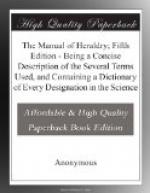Of a royal duke
[Illustration: Coronet, earl]
Of an earl
[Illustration: Coronet, duke]
Of a duke
[Illustration: Coronet, viscount]
Of a viscount
[Illustration: Coronet, baron]
Coronet of a baron
DANCETTE. A zig-zag figure with spaces between the points, much larger than in the indented.
[Illustration: Dancette]
Ex. Argent, a pale, dancette vert.
DEBRUISED. Any animal that has an ordinary placed upon it is said to be debruised.
[Illustration: Debruised]
Ex. Argent, a lion rampant guardant gules, debruised by a fess azure.
DECRESSANT, or DECRESCENT. A moon in its wane, whose horns are turned to the sinister side of the escutcheon.
[Illustration: Decressant]
Ex. Azure, a moon decrescent, proper.
DEMI, or DEMY. This particle is always joined to a substantive, and signifies half; as, a demi-lion, i.e. half a lion.
DETRIMENT. The moon is said to be in its detriment when it is eclipsed.
[Illustration: Detriment]
Ex. Argent, the moon in her detriment sable.
DEXTER. A word used in Heraldry to signify the right side of any thing.
DIADEM, a circle of gold with points rising from it, worn by ancient kings as the token of royalty. The diadem of most of the monarchs of Europe, as represented in ancient statuary, stained glass, and paintings, resembles the annexed engraving; the kings of England, from the Conquest to Henry VII., all wore a diadem of this shape.
[Illustration: Diadem]
DIAMOND. The hardest and most valuable of precious stones; it was formerly used by English heralds to denote black or sable in blazoning the arms of the nobility.
DIFFERENCE. The term given to a certain figure added to coats of arms to distinguish one family from another, and to show how distant younger branches are from the elder or principal branch. See p. 13. [CHAP. III.]
DIMINUTION. A word sometimes used instead of difference.
DISPLAYED. A bird whose wings are expanded and legs spread is said to be displayed.
[Illustration: Displayed]
Ex. Argent, an eagle displayed sable.
DORMANT. The French word for sleeping, used to denote the posture of a lion, or any other beast reposing. See LION.
DOUBLINGS. The lining of robes of state, as also the rows of fur set on the mantles of peers.
DOUBLE TRESSURE. Two Tressures, or orles, one within the other.
[Illustration: Double Tressure]
DOVETAILED. A term borrowed from carpentry to show tinctures joined together by reversed wedges, which, being shaped like doves’ tails, are by joiners called dovetailing.
[Illustration: Dovetailed]
Ex. Quarterly per pale dove-tailed, or and gules.




